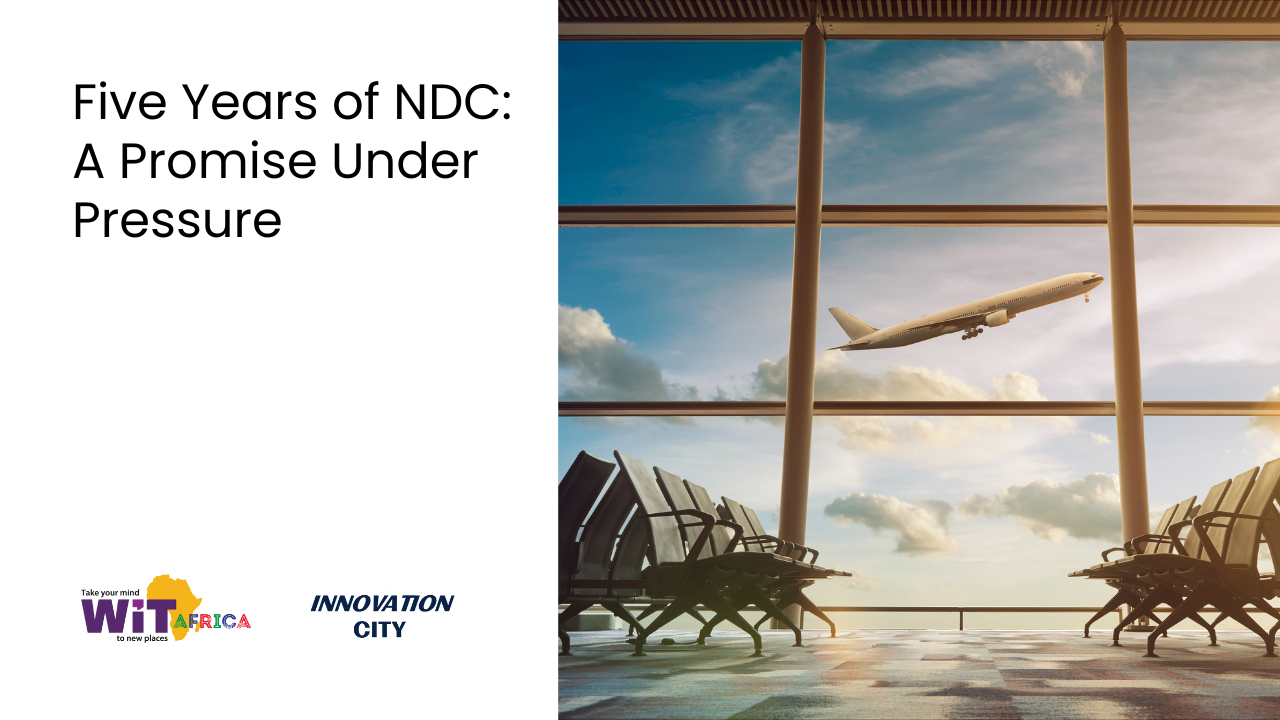
15 Sep Five Years of NDC: A Promise Under Pressure
When the New Distribution Capability (NDC) first emerged on the global travel scene, it was pitched as the next big leap for the airline industry. Developed by IATA and launched to modernise airline distribution, NDC was envisioned as a single, standardised protocol that would allow airlines to retail more like e-commerce platforms. Five years into its wider global rollout, the Web in Travel Africa Pop-Up Series 2, hosted at Innovation City Cape Town, took a hard look at the real-world results.
Moderated by Andy Hedley, Group CEO of Travelstart, the panel featured Caroline Smallwood, GM of Amadeus, Dale Woodhouse, Regional Manager of Central & Southern Africa for Singapore Airlines, and Sue Garrett, GM for Supply, Pricing & Marketing for Flight Centre South Africa. Together, they unpacked the ambitions of NDC against the reality of its implementation.
A Tipping Point on the Horizon
One of the key themes of the afternoon was the shifting momentum around NDC adoption. In markets such as India and the Maldives, penetration rates are already reaching above 80 to 90 percent. South Africa is not far behind. According to Andy Hedley, the industry is approaching a tipping point. Within the next two years, the majority of bookings in this region are likely to be NDC-based, a milestone that marks the beginning of a new standard in airline distribution.
However, this acceleration in adoption is not without consequence. While some players have raced ahead, others are still struggling to keep pace, creating tension across the ecosystem.
The Breakdown of Standardisation
A major revelation from the session was the failure of NDC to fulfil its original goal as a universal standard. Instead of one integration model, each airline has developed its own customised implementation of NDC, effectively undoing the benefits of simplification. The dream of a plug-and-play solution for travel agents and tech platforms has given way to a more complex reality, where each airline must be integrated separately. For many travel sellers, especially smaller or mid-sized agencies, this has created an unsustainable technical and financial burden.
This complexity has driven the emergence of a new layer of infrastructure: the NDC aggregator. These third-party providers have become essential for consolidating fragmented airline content and enabling access to a broader range of fares without the need for direct integration with each airline. Even for larger travel companies, aggregators are often a strategic necessity for non-core airline partnerships.
Benefits for Airlines, Burdens for Agents
Despite the shortcomings in standardisation, the panel agreed that airlines implementing NDC effectively are already seeing tangible benefits. Fare diversity has increased dramatically, from just a handful of price points to over ten in many cases. Ancillary sales have improved, transparency has increased, and distribution costs have come down.
Singapore Airlines was cited as a best-in-class example, thanks to its structured rollout and responsiveness to agent feedback. Dale Woodhouse highlighted the airline’s methodical approach, including quarterly system enhancements, maintaining parallel distribution systems during the transition, and investing in trade education. This consistency has helped build trust in the channel and drive adoption without creating undue friction.
On the other side of the value chain, however, travel agents are shouldering increased complexity. Booking servicing, especially post-sale changes, refunds, or special requests, has emerged as the single biggest pain point. With no standard servicing logic across airlines, agents are often left to navigate a patchwork of support systems, rules, and error-prone manual processes. This has significantly increased operational costs and made it difficult for agents to confidently adopt NDC content at scale.
The Unfulfilled Promise of Personalisation
One of NDC’s most compelling early promises was the ability to deliver highly personalised, Amazon-like shopping experiences. In practice, this remains largely unfulfilled. While corporate travel has seen some advancements through the use of loyalty and profile data, the leisure segment still operates in a one-size-fits-all model. Most technology providers and airlines have prioritised stability and baseline functionality over advanced personalisation. According to the panel, real innovation in this area is likely still several years away.
The complexity of traveller data ownership, consent, and real-time decisioning further complicates efforts to build dynamic, customer-specific offers. Until those issues are resolved, personalisation will remain more aspiration than reality.
Collaboration as the Critical Enabler
If there was one clear call to action from the discussion, it was this: NDC will not reach its full potential unless the industry begins to collaborate more meaningfully. Airlines, technology providers, aggregators, and travel agents all have a role to play in shaping a functional, customer-centric system. This means listening to agent feedback, committing to regular system improvements, and aligning commercial incentives with user experience outcomes.
Without this level of cooperation, NDC risks becoming a source of further division rather than progress. The risk, according to Sue Garrett, is that travellers ultimately bear the brunt of inefficiencies—and when the customer loses, the entire value chain suffers.
Looking Ahead
The panel concluded that while progress has been uneven and at times frustrating, the industry is on a slow but determined path toward NDC maturity. Most speakers agreed that full market-wide adoption is possible by 2030, though it will require smarter execution, deeper collaboration, and a renewed focus on the traveller experience.
The conversation at WiT Pop-Up Series 2 was a timely reminder that technological transformation is never just about tech. It’s about people, process, and partnership. The stakes for the industry are high, but so too is the potential upside if NDC can truly evolve from a standard to a scalable solution.
Web in Travel Africa will return to Cape Town in April 2026, continuing the dialogue and pushing the industry forward one conversation at a time.



